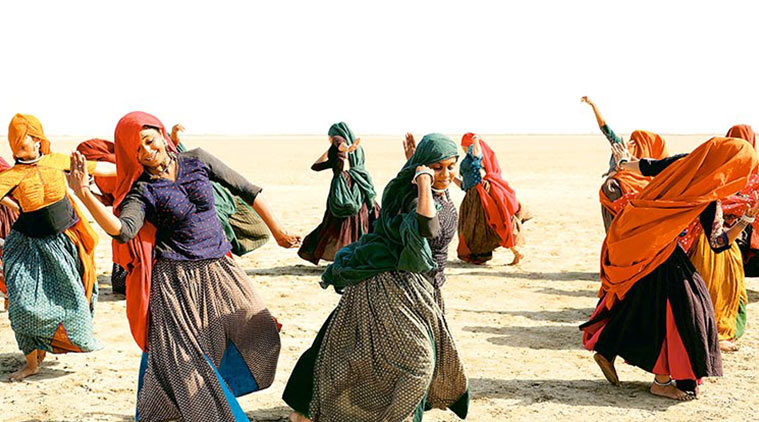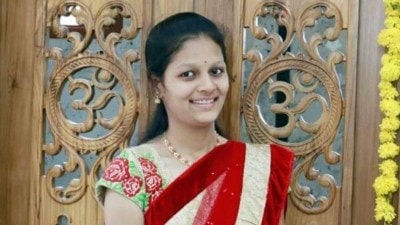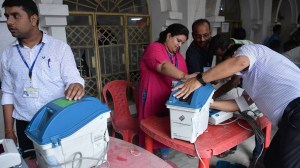- India
- International
The importance of garba in National Award-winning Gujarati film Hellaro
An award-winning film turns a Kutchi folktale into a parable about the suppression of women by patriarchy
 A still from Hellaro, surprise winner of the National Award for Best Feature Film this year and the opening film of the Indian Panorama’s features section at the upcoming International Film Festival of India, Goa,
A still from Hellaro, surprise winner of the National Award for Best Feature Film this year and the opening film of the Indian Panorama’s features section at the upcoming International Film Festival of India, Goa,
Sisterhood and humour keep the women in the Gujarati film Hellaro going until they discover that they can dance too. Life in this arid land is tough and societal norms are tougher. They can’t ask questions or dare to dream. As they trek long and hard every day just to fetch water, one of them says that “when suppressed for long, desires can turn poisonous”. To this, another retorts, “poisonous beings often sting”.
Hellaro (The Outburst), surprise winner of the National Award for Best Feature Film this year and the opening film of the Indian Panorama’s features section at the upcoming International Film Festival of India (IFFI), Goa, wastes no time in establishing the deep-seated patriarchal norms prevalent in the village as well as suggesting that there is a price to pay when desires are crushed.
Debutant director Abhishek Shah, who is also the writer and co-producer, developed this story after he heard a local folktale about a group of women who are forbidden from doing garba (a Gujarati folk dance). After a chance encounter with a drummer, they dance for days together to his drumbeat. This angers the menfolk, who end up killing the drummer. Following this, the women commit suicide in protest and grief. “There are many versions of this folktale. In some versions, the drummer is said to be Lord Krishna in disguise,” recalls Shah.
An Ahmedabad-based playwright and theatre director, Shah, 37, had nurtured the ambition of telling a story on the big screen that’s rooted in Gujarati life and culture. “The strictures about how women should lead their lives are still dictated by patriarchy. When I first heard this story, I instantly knew I would like to tell it on a bigger scale. I could have written a play about it but I knew the medium of film would take it to a wider audience,” says the director, who identifies as a feminist. The trigger to make a women-centric movie also came from personal experience: a female friend told him that, on social media, she would rather post photos of landscapes or gods, as her profile photo, than her own, for fear of displeasing her husband.
Through the story of Hellaro, Shah explores the idea of women in a village finding “self-expression” through garba. The story is set in 1975, in a fictional Kutchi village that has had no rainfall for many monsoons. Shah had decided on this setting and the use of garba from the beginning. The decision to set the story in 1975, when the Emergency was imposed, came later. “The Emergency is a metaphor as, even today, women are bound by societal rules. That apart, I wanted a world that’s devoid of mobile phones and other modern amenities to make the story convincing,” Shah says. After the movie’s release on November 8 in Gujarat and some cities around the country, filmmaker is planning to take it to prominent Indian cities, in phases, depending on the response it gets.

 Telling tales: Filmmaker Abhishek Shah.
Telling tales: Filmmaker Abhishek Shah.
Being a period drama, Hellaro demanded a certain purity in the way garba was presented. Choreographer Sameer Tanna, who has worked on movies such as Hum Dil De Chuke Sanam (1999) and Goliyon ki Rasleela Ram-Leela (2013), says, “The challenge was to come up with steps which are authentic, as garba was not so commercialised in the ’70s.” The audition of the actors was a long process, as Shah, who has also been a casting director, tested dancing skills as well. Traditionally, garba is a prayer dance performed by men and women who dance around an idol or image of the goddess Amba. “Even today, there are communities in Gujarat that don’t allow men and women to dance together,” Tanna says .
Shooting the dance sequences alone required 14 days out of the 35-day schedule. The shoot began in March, 2018; filming in 45 degrees Celsius was a major challenge. “Even though we tried a de-glam look for the actors, in the heat, we had to be careful about their make-up (so that it wouldn’t run). We also had to be mindful of (traditional) tattoos, which the actors were sporting, for continuity. They were temporary ones and could last up to three days,” says Shah.
The National Film Award jury also conferred 13 actors of the film — Shraddha Dangar, Shachi Joshi, Denisha Ghumra, Neelam Paanchal, Tarjani Bhadla, Brinda Nayak, Tejal Panchasara, Kaushambi Bhatt, Ekta Bachwani, Kamini Panchal, Jagruti Thakore, Riddhi Yadav and Prapti Mehta — with a special Jury Award for acting as a unit “to bring about social transformation while taking the audience through an emotional catharsis”.
The team also had to create a village where they could shoot. “After the 2001 earthquake, concrete houses have been constructed in place of the traditional mud ones. To shoot the film, we built a village 10 km from the Indo-Pak border in a place called Kuran, 90 km away from Bhuj. Since it is a restricted area, controlled by the security forces, we had to get permission from the Home Ministry,” says Prateek Gupta, who has co-written the screenplay and edited the movie.
While writing the film, the two were very clear that they wanted to make an “accessible” film. Gupta says, “We wanted to maintain a balance of mainstream treatment and arthouse flavour. The idea was that the movie should communicate with a larger audience. That’s why we roped in (poet and playwright) Saumya Joshi to write the dialogues and lyrics for the film,” says Gupta. The need for accessibility may also be the reason why the film clearly highlights the irony of worshipping Amba while ill-treating women at home. The idea of the patriarchal power system leaves little to the imagination.
Yet, the movie breaks away from the prevalent trend of making low-budget formulaic Gujarati movies, which are mostly poor copies of popular Hindi movies. Shah hopes that Hellaro will do what Shwaas (2004), selected as India’s Oscar entry that year, did for the revival of Marathi cinema. “I’ve been receiving calls from aspiring filmmakers. Hellaro might encourage them to try original subjects,” says the writer-director.
This article appeared in the print edition with the headline ‘Dance Like a Woman’
Apr 19: Latest News
- 01
- 02
- 03
- 04
- 05






































